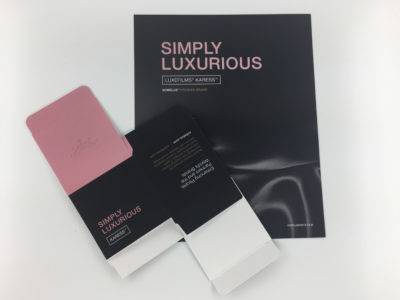Do you remember Flat Stanley from your childhood? Inkjet can sometimes seem as flat as Stanley because some inkjet ink and paper combinations can have less density and depth than offset or toner devices. Stanley made the most out of being flat, but you can do more than that. Adding a tactile differentiator to the print is the simplest way to gain attention and make inkjet print stand out.
Soft-Feel applications have been around for offset and toner for decades, but recently they seem to be all the rage for inkjet too. Often called Soft-Touch, this haptic effect comes in liquid form for in-line or off-line post-coat applications. For laminate films, it is usually referred to as Soft-Feel or Sensual Laminate. Traditionally applied after printing, this effect offers another depth to any print market.
Liquid applications such as MGI apply a coating chemistry to non-porous media such as coated stocks. This reduces the coating absorption into the media and flattens the effect of the papers coating. Companies such as Nobelus, who make both the specialty laminate films and application equipment, are used with both porous and non-porous media making it a nice option for projects which are cross media.
Both liquid coating and laminate applications are compatible with aqueous and UV inkjet printed on paper, nylon, polyethylene terephthalate (PET) and polypropylene (OPP). Soft-Feel laminate is usually OPP, but can also be PET or Nylon. The type of application will dictate which is most appropriate. For example, OPP is perfect for single-side value-add surface effects, while a PET is great for encapsulation or protecting ID cards. Nylon is best known for its lay-flat characteristics in perfect bound book production.
Important to note, a more aggressive thermal adhesive is usually necessary to optimally bond to inkjet/UV inkjet and in some cases, an infrared device, on the lamination equipment, is necessary to out-gas certain elements within the ink to enhance adhesion.
Designing with Emotion
The haptic effect of these coatings is a subtle texture which feels like soft suede or velvet and can be applied to just about any print market. Primarily used on book covers, corporate collateral and packaging. This effect can be applied wherever a designer would like to change the user’s experience or appeal to more senses, like touch.
Soft-Feel effects can add emotion and play on our senses when added to graphics. Using it for a spot feature for flower pedals on flexible packaging or products within a catalog adds a visceral experience to the printed product making the piece feel more personal and memorable.

Photo compliments of Nobelus
When added to images such as fur, grass, or patterns, spot layering effects and screening can create image depth through light reflection in addition to the expected touch aspect of the product.
For deep printed colors such as dark blues or process blacks, adding soft feel laminate effects can create a sense of luxury whereas for pastels relays a calming effect.
As soft-feel can evoke various feelings and emotion, it is best to truly understand what the product should convey or how the brand’s messaging aligns with the desired effect. Alignment is critical since a soft-feel effect may not work as well on dog food as it would on perfume or chocolate. Alternatively, a scuff-resistant surface may complement dog food packaging by communicating strength, endurance and a long-life.
InkjetInsight is here to help along the way. Our Finishing Finder lists the top suppliers for all cool inkjet finishing and embellishment options. Become a free member and utilize this resource to understand all your options, when and how to apply and find printers which have such capabilities.
“Design Wisely, Color Manage Correctly, Print Productively and Finish Fabulously” –Mary Schilling

